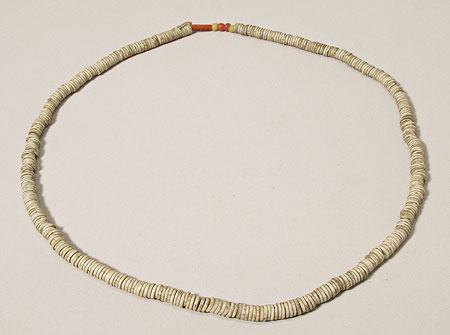Accession Number:
1919.29.35
Country:
Sudan
Date Made:
By 1919
Materials:
Ostrich Eggshell Bird , Glass , ?Cotton Yarn Plant , String
Process:
Chip Carved , Perforated , Ground , Wound , Strung
Dimensions:
L string = 385 mm, Diam shell beads 7.5 mm, Th shell beads = 1 mm; L cylinddrical bead = 14 mm, W cylindrical bead = 4 mm, Th cylindrical bead = 3.5 mm; Diam yellow disc bead = 5.5 by 5 by 4 mm [RTS 3/6/2004].
Weight:
69.2 g
Other Owners:
Harry Hamilton Jackson
Field Collector:
Harry Hamilton Jackson
PRM Source:
Harry Hamilton Jackson
Acquired:
Donated 1919
Collected Date:
By 1919
Description:
A single length of twisted cord, made from a white, soft, fibrous plant material, possibly cotton, that looks European.
The ends have been tied together with a double knot.
The cord has been strung with 428 beads, consisting of (in order), 1 long orange glass cylindrical bead, 1 yellow glass ring bead, 2 orange glass ring beads, 1 yellow glass ring bead, then 423 disc-shaped beads cut from ostrich eggshell.
The yellow glass beads are opaque (Pantone 127C) and the orange beads of both forms have an opaque white core coated with orange glass (Pantone 173C) - all three types were probably manufactured by winding a glass filament around a mandrel.
The ostrich eggshell beads are a creamy white colour (Pantone 7506C) and were probably made by being chipped into a rough disc shape, perforated, and then ground down around their edges.
The necklace is complete, with some minor chipping to the occasional eggshell bead; there is also a fair amount of surface dirt present.
As strung, the necklace has a length of 385 mm; the eggshell beads are very regular in size, with a diameter of 7.5 mm, a thickness of 1 mm, and 2 mm diameter thread holes.
The long cylindrical bead has a length of 14 mm, a width of 4 mm and thickness of 3.5 mm; the disc beads are of similar dimensions to one another, with one yellow example measuring 5.5 by 5 by 4 mm.
The necklace weighs 69.2 grams.
Collected by Harry Hamilton Jackson in the Sudan.
Carey suggests that ostrich eggshell beads were made by chipping the material to the correct size then boring a hole through it, after soaking the eggshell in water to prevent the material splitting. Several partially worked beads could then be strung together and the edges ground to finish them off. It was possible to make around one hundred beads of this kind per day (M. Carey, Beads and Beadwork of East and South Africa, 1986, p. 9).
Rachael Sparks 30/9/2005.
Collected by Harry Hamilton Jackson in the Sudan.
Carey suggests that ostrich eggshell beads were made by chipping the material to the correct size then boring a hole through it, after soaking the eggshell in water to prevent the material splitting. Several partially worked beads could then be strung together and the edges ground to finish them off. It was possible to make around one hundred beads of this kind per day (M. Carey, Beads and Beadwork of East and South Africa, 1986, p. 9).
Rachael Sparks 30/9/2005.
Primary Documentation:
Accession Book Entry
[VI, p.
132] - 1919.
[pencil insert] 29 [end insert]
REV.
H.
HAMILTON JACKSON
, M.A.
Milton Rectory, Steventon, Berks.
[...] The following collected by himself in the ANGLO-EGYPTIAN SUDAN.
[pencil insert, p.
133] 35 [end insert] - Necklet of ostrich-egg-shell disk beads.
Card Catalogue Entry - There is no further information on the tribes catalogue card [RTS 28/1/2004].
Pitt Rivers Museum label - Necklet of ostrich-egg shell beads. EASTERN SUDAN. d.d. Rev. H.H. Jackson, 1919 [circular metal edged tag, tied to object; RTS 19/5/2004].
Card Catalogue Entry - There is no further information on the tribes catalogue card [RTS 28/1/2004].
Pitt Rivers Museum label - Necklet of ostrich-egg shell beads. EASTERN SUDAN. d.d. Rev. H.H. Jackson, 1919 [circular metal edged tag, tied to object; RTS 19/5/2004].



